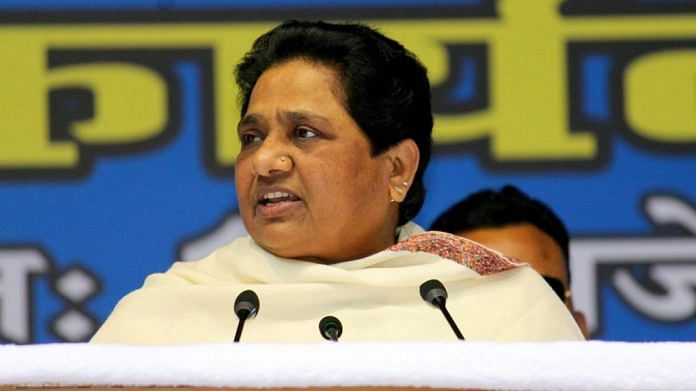BSP is the only party apart from the BJP and the Congress with a truly national footprint and wants adequate reward for it.
New Delhi: After Nitish Kumar’s Janata Dal (United) broke ranks from the 2015 grand alliance of the Rashtriya Janata Dal and the Congress in Bihar, hopes of a broad-based alliance to take on the Bharatiya Janata party suffered a huge setback.
These hopes got a fresh momentum after an alliance of the Bahujan Samaj Party (BSP) and the Samajwadi Party (SP) defeated the BJP in by-polls for the Gorakhpur and Phulpur lok sabha seats. The grand coalition narrative got a further boost when the Congress, Janata Dal (Secular) and the BSP came together to form the Karnataka government. The JD(S) and the BSP had fought the Karnataka elections in a pre-poll alliance.
Also read: BJP goes into huddle after Mayawati and Jogi tie-up in Chhattisgarh
This experiment triggered speculations of the Congress and the BSP coming together in the forthcoming assembly elections in the states of Rajasthan, Madhya Pradesh and Chhattisgarh. This author had pointed out in an earlier piece that a pre-poll alliance between the Congress and the BSP was ahead of the BJP in terms of vote share in six out of nine assembly elections held in these three states since 2003.
Ironical as it may sound, it is the BSP today which has once again created uncertainty around hopes of a grand collation against the BJP. Earlier this week Mayawati announced that the BSP was prepared to fight the elections on its own if it were not given a “respectable” number of seats. On 20 September, the BSP announced a pre-poll alliance with Ajit Jogi’s party in Chhattisgarh and also announced 22 candidates in Madhya Pradesh.
What explains this behaviour by the BSP?
The party paid dearly by contesting alone in the 2014 lok sabha elections and 2017 assembly elections in Uttar Pradesh (UP). It did not win even one Lok Sabha seat in 2104 and had the lowest seat share to vote share ratio – a useful indicator of a party’s ability to convert popular support into seats in the first-past-the-post system – in the UP assembly since 1989. It is also true that the index of opposition unity against the BJP in the 2019 elections will be greater than what it was in 2014, whether or not the BSP becomes a part of it.
So where is the BSP getting the confidence from to play this risky game? The short answer is that the BSP is the only party apart from the BJP and the Congress with a truly national footprint and wants adequate reward for it.
HT has used statistics from the Trivedi Centre for Political Data at Ashoka University to calculate mean and median vote share of parties in the 2004, 2009 and 2014 lok sabha elections at the parliamentary constituency (PC) level. In terms of mean vote share at the PC level, the BSP was ranked third in all these three elections.
Also read: Mahagatbandhan gets a Mayawati reality check as BSP raises the stakes
However, a mean vote share can be misleading to measure a party’s national footprint as it can get affected by extreme values. For example, if a party had 40% vote share in all 80 lok sabha seats in UP and no votes in any other PC in India its mean vote share at the PC level will be 5.9%. This number however does not capture the party’s level of support at all-India level.
The median vote share is a better indicator this because it measures the “middle value” of vote share across all 543 PCs and hence it not affected by extreme values in a few seat or states. Not only is the BSP ranked third in terms of median vote share at the PC level in the 2004, 2009 and the 2014 elections; it was the only non-Congress non-BJP party to have a non-zero median vote share in the 2004 and 2009 elections. In the 2014 elections, the Aam Admi Party was the only party other than the BJP, Congress and the BSP to have a non-zero median vote share at the PC level.

In simple terms this means that the BSP can actually credibly boast of having a 1% plus vote share in more than 200 PCs across India. In a closely contested election, a pre-poll alliance with the BSP could be a decisive factor in a significant number of seats.
Also read: What exactly is Mayawati up to
This has to broad implications. One, BSP’s electoral ambitions are not likely to be confined to Uttar Pradesh. Two, it will be a better strategy to seal with the BSP at a national level than state level, as these 200 plus seats are bound to be spread across India.
By special arrangement with ![]()






